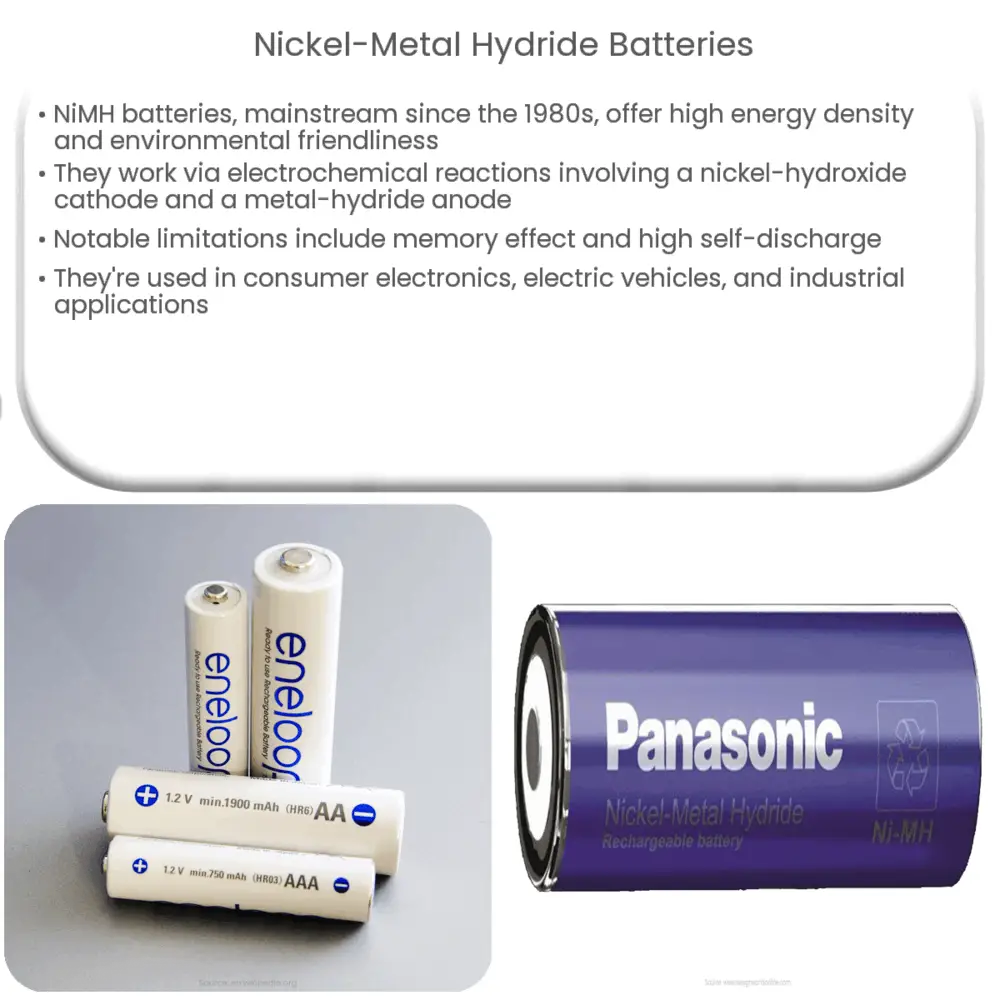Explore the world of Nickel-Metal Hydride (NiMH) batteries: their chemistry, advantages, limitations, and diverse applications.

Nickel-Metal Hydride Batteries: A Comprehensive Overview
In the world of rechargeable batteries, Nickel-Metal Hydride (NiMH) batteries are a significant player. They have marked their presence due to their robust and flexible nature, thus finding wide applications in various domains.
Introduction
The birth of NiMH batteries can be traced back to the 1970s. However, their mainstream usage began in the 1980s, primarily as an improved alternative to Nickel-Cadmium (NiCd) batteries. NiMH batteries offer similar electrical characteristics to NiCd but carry a critical advantage – a significantly higher energy density.
The Chemistry Behind NiMH Batteries
At its core, a NiMH battery operates on the principle of electrochemical reactions. The cell consists of a nickel-hydroxide cathode, a metal hydride anode, and an alkaline (potassium hydroxide) electrolyte.
- Cathode: The cathode is the positive electrode of the battery and is comprised of nickel hydroxide (NiOOH).
- Anode: The anode, being the negative electrode, consists of a metal hydride alloy.
- Electrolyte: The electrolyte enables the flow of ions, facilitating the chemical reaction that produces electricity. In NiMH batteries, an alkaline electrolyte, typically potassium hydroxide (KOH), is used.
The primary electrochemical reaction during the discharge of a NiMH battery can be represented as:
NiOOH + MH2 ↔ Ni(OH)2 + M
Where NiOOH denotes the nickel-hydroxide cathode, MH2 represents the metal-hydride anode, and M denotes the metal.
Advantages of NiMH Batteries
NiMH batteries offer a plethora of advantages, making them an attractive choice for a range of applications.
- High Energy Density: NiMH batteries provide a higher energy density compared to their NiCd counterparts. This means they can store more energy for the same size, giving them an edge in portable applications where space and weight are considerations.
- Environmentally Friendly: Unlike NiCd batteries, NiMH batteries do not contain toxic cadmium, making them a more environmentally friendly option.
- Good Cycle Life: NiMH batteries typically offer a good cycle life, meaning they can be recharged and discharged many times without significant degradation.
Limitations of NiMH Batteries
Despite their numerous advantages, NiMH batteries are not without limitations, which are worth considering when choosing a battery technology.
- Memory Effect: NiMH batteries can suffer from a phenomenon known as ‘memory effect’. If a battery is repeatedly only partially discharged before recharging, it may ‘forget’ its full capacity, leading to decreased performance. However, this effect is much less pronounced in NiMH batteries than in NiCd batteries.
- Self-Discharge: NiMH batteries can also exhibit high self-discharge rates, losing a significant portion of their charge while not in use. Advanced versions, known as Low Self-Discharge NiMH (LSD NiMH), have largely mitigated this issue.
- Performance in Extreme Conditions: The performance of NiMH batteries can degrade in extreme temperatures, particularly cold conditions.
Applications of NiMH Batteries
NiMH batteries have found widespread usage in several applications owing to their robust features.
- Consumer Electronics: From cordless phones, digital cameras, to handheld games, NiMH batteries are often used in various consumer electronics due to their high energy density and rechargeability.
- Electric Vehicles: Due to their high energy density and environmental friendliness, NiMH batteries have been used in electric vehicles and hybrid electric vehicles. While the trend is shifting towards Lithium-ion batteries, NiMH technology still plays a significant role.
- Industrial Applications: NiMH batteries are used in various industrial devices such as power tools and two-way radios.
Conclusion
In summary, Nickel-Metal Hydride (NiMH) batteries are a vital part of our daily lives, powering everything from consumer electronics to electric vehicles. Their high energy density, good cycle life, and environmental friendliness make them a versatile and sustainable choice for a wide array of applications. However, like any technology, they come with certain limitations, including memory effect and self-discharge. Nevertheless, ongoing research and technological advancements continue to improve their performance, further solidifying their position in the world of rechargeable batteries.

